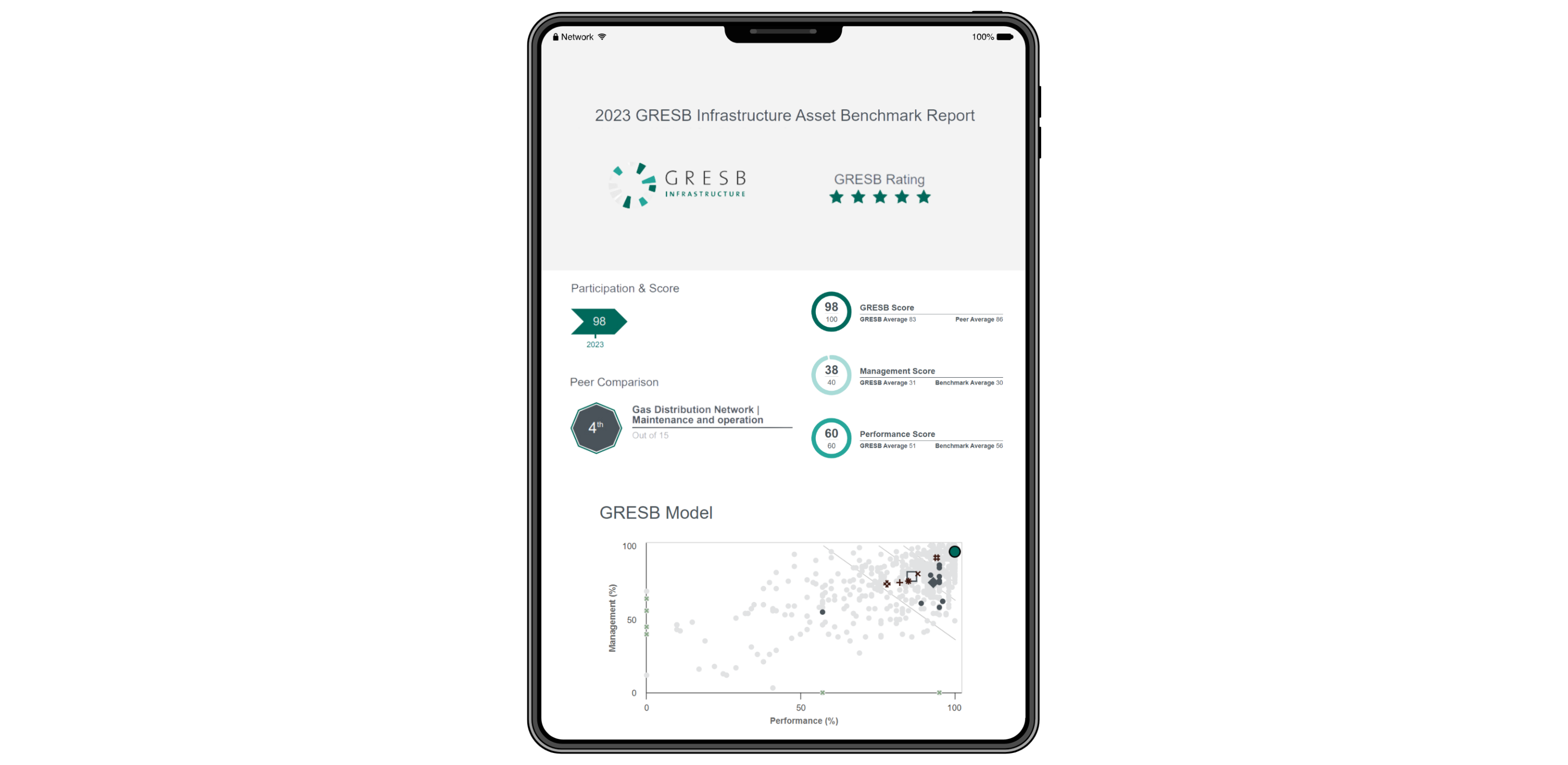What is the GRESB Infrastructure Asset Assessment?
The GRESB Infrastructure Asset Assessment provides the basis for systematic reporting, objective scoring and peer benchmarking of ESG management and performance of infrastructure assets around the world. Both single and multi-asset operators can participate and the process leads to deep data insights for investors, fund managers and asset operators.
The data is self-reported by Assessment participants between April 1 and July 1 each year and subjected to a multi-layer validation process after which it is scored and benchmarked. The result is high-quality data that investors and participants can use in their investment and decision-making processes.
Benefits of Participating
- Attract new investors seeking more comprehensive risk, opportunity and impact analysis.
- Identify areas of risk, opportunity and impact in your infrastructure asset.
- Systematically improve your investor and fund manager engagement.
- Get a clear picture of your ESG performance, how it compares against your peers and what you can do to improve.
- Report validated ESG performance information to the market using a global industry standard.
- Provide input into Assessment, Component and Module development.
Infrastructure Asset Assessment Components
The Assessment is structured into separate Management and Performance Components. Each Component determines an individual score, but only entities that submit both Components will receive a GRESB Score and GRESB Rating.

Management Component
The Management Component measures the entity’s strategy and leadership management, policies and processes, risk management and stakeholder engagement approach, comprising of information collected at the organizational level.
The Component is suitable for any type of infrastructure company, asset and investment strategy. It is validated, scored and peer-benchmarked using the globally recognized GRESB methodology, and can be completed individually or in combination with the Performance Component.
It is structured into 5 aspects:
- Leadership
- Policies
- Reporting
- Risk Management
- Stakeholder Engagement

Performance Component
The Performance Component measures the entity’s performance, comprising of information collected at the asset level. It is suitable for any infrastructure company with operational assets.
It is structured into 12 aspects:
- Implementation
- Output & Impact
- Health & Safety
- Energy
- Greenhouse Gas Emissions
- Air Pollution
- Water
- Waste
- Biodiversity & Habitat
- Employees
- Customers
- Certifications & Awards
What sectors does GRESB Infrastructure cover?
The GRESB Infrastructure Asset Assessment is designed to assess ESG performance across a wide range of sectors. It applies sector-based materiality weightings to tailor the assessment to different infrastructure sectors, including:
- Data Infrastructure
- Energy & Water Resources
- Environmental Services
- Network Utilities
- Power generation (excl. Renewables)
- Renewable Power
- Social Infrastructure
- Transport
Assessment process
Systematic assessment
Validation
GRESB has established a robust data validation process to underpin the accuracy and reliability of its output. It is based on a three-layer data quality control process designed to ensure submission of high-quality information. The approach to validation was developed by PwC and involves third-party verification by SRI.
Objective scoring
The GRESB Scoring Model is based on an automated system, which uses a technology platform designed for GRESB by a third party that specializes in data analysis software development. The scoring is completed without manual intervention after data input.
Peer benchmarking
Peer comparisons that take into account country, regional, sectoral and investment type variations provide a powerful lens through which to benchmark performance. Each participant is assigned to a peer group, based on the entity’s legal structure (listed/private), property type and geographical location of assets.
…

Assessment results
Participants receive the GRESB Benchmark Report and Portfolio Analysis Tool. These provide an in-depth analysis of sustainability performance, enable detailed peer group comparisons and highlight industry best practices.
First year participants can submit the Assessment without providing GRESB Investor Members and Fund Manager Members with the ability to request access to their results. This is referred to as a “Grace Period”.
Assessment Resources
- 2024 Infrastructure Asset Assessment Standard – List of Changes Summary Table
- 2024 List of Changes for Infrastructure Asset Assessment Standard
- 2024 Infrastructure Asset Materiality & Scoring Tool
- 2024 Infrastructure Asset Standard and Reference Guide
- 2024 Infrastructure Asset Scoring Document
- 2024 Infrastructure Indicators Summary
- 2024 Infrastructure Asset Assessment (Excel format)
- 2024 Infrastructure Asset Certification Evaluation Form
- 2024 Infrastructure Supplementary Guidance on Scope 3 Emissions
- How to read your Infrastructure Asset Assessment benchmark report
ESG due diligence tool for Infrastructure Assets
GRESB and B Capital Partners AG have released a stand-alone, open-source ESG due diligence tool (ESG DD Tool) for infrastructure assets.
The ESG DD Tool is not tied to the GRESB Assessment cycle and can be used at any time to gain a clear understanding of the ESG risks and opportunities of an asset.
Interested in the Infrastructure Asset Assessment? Contact us!
"*" indicates required fields